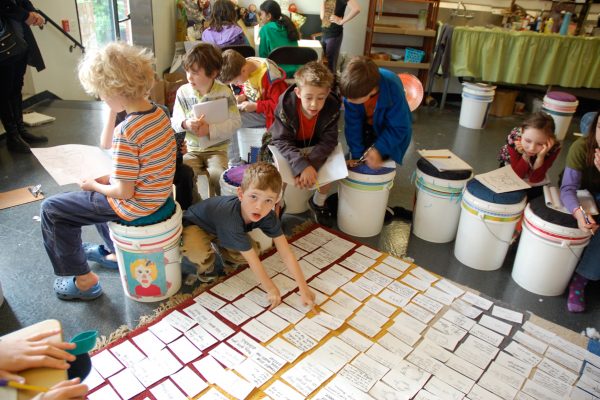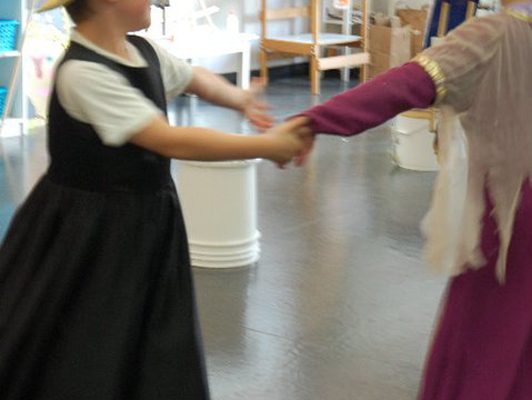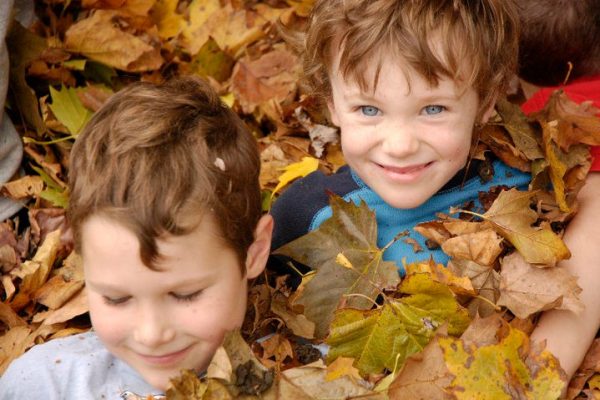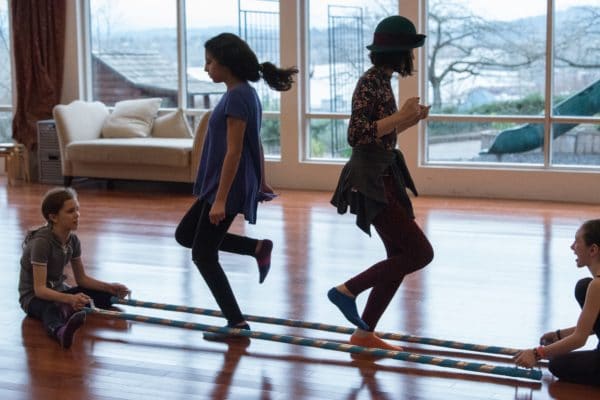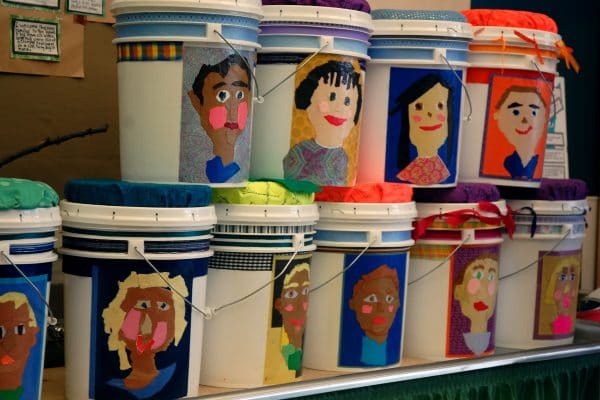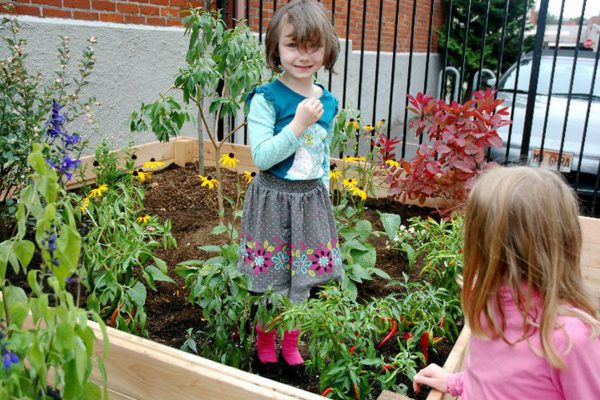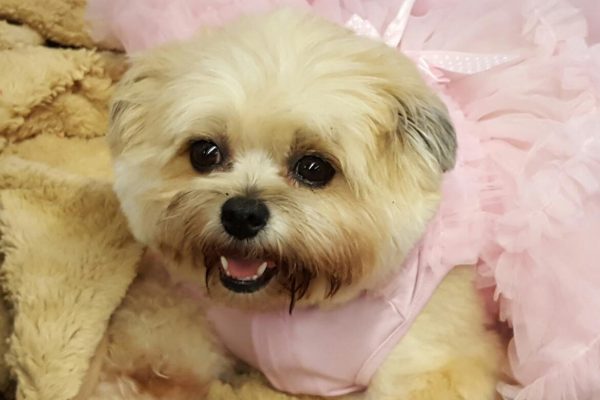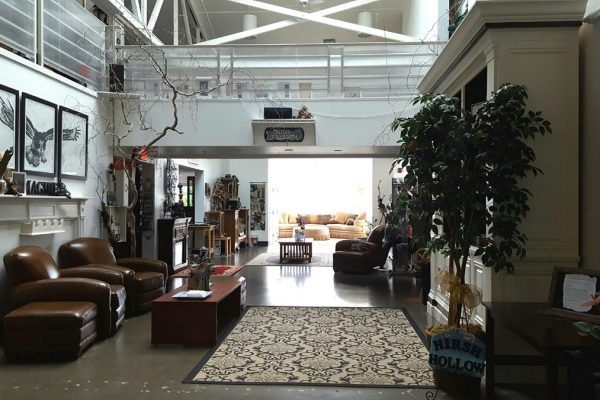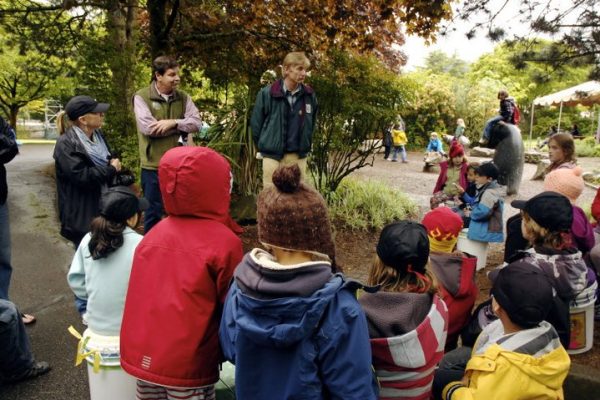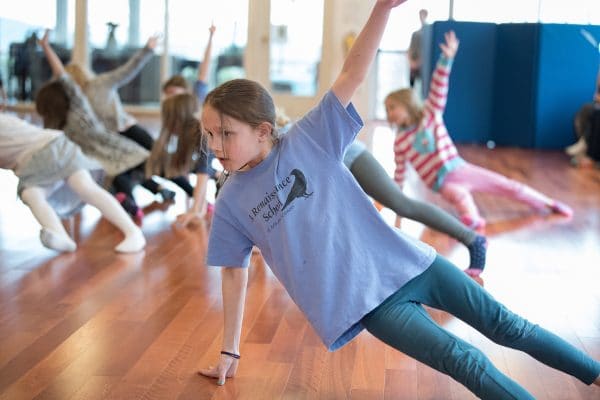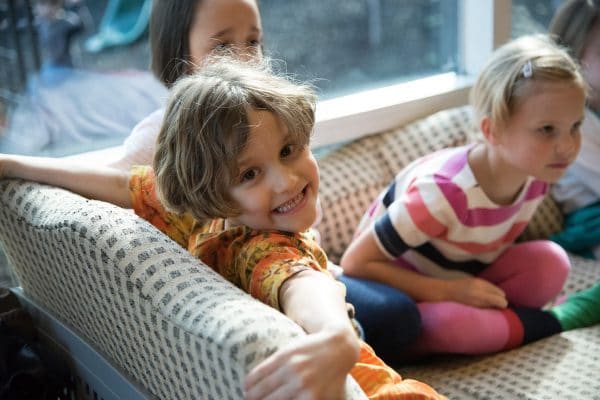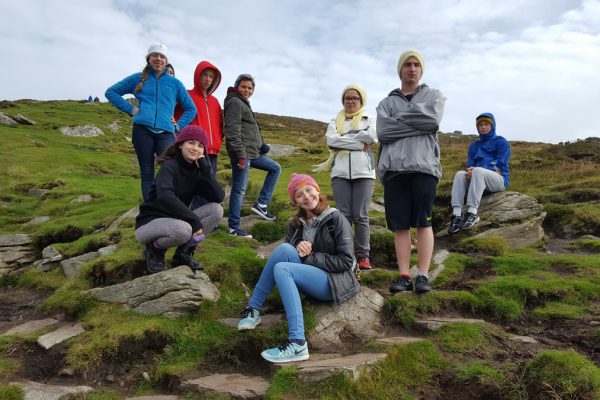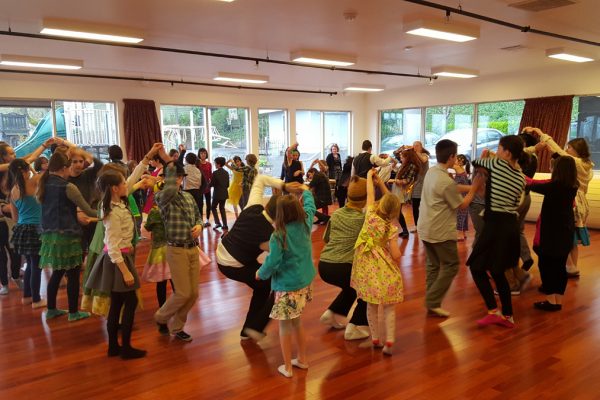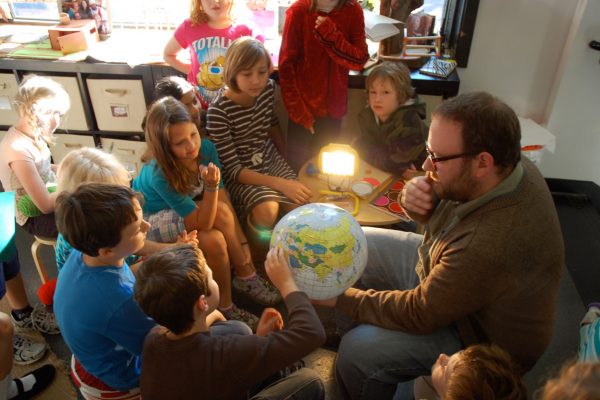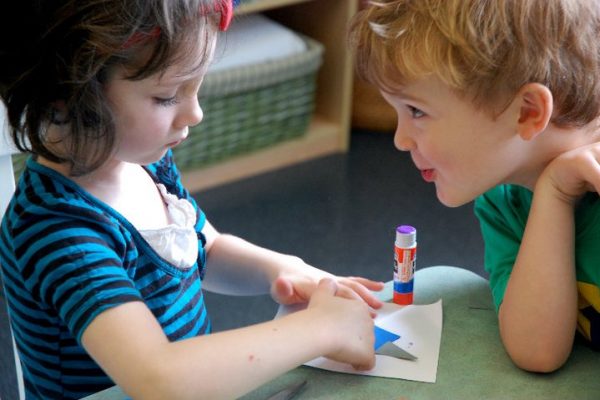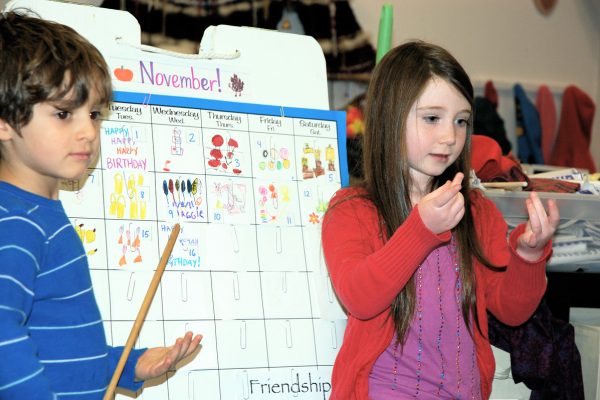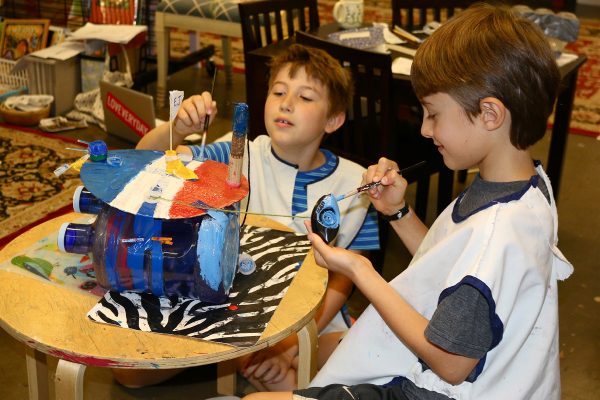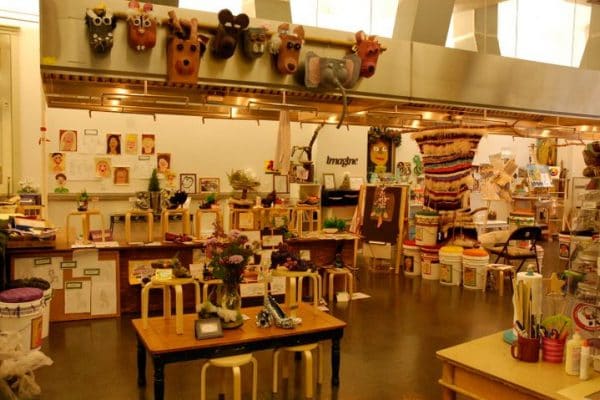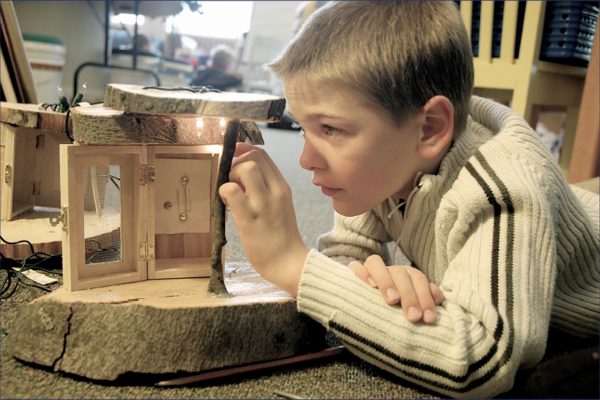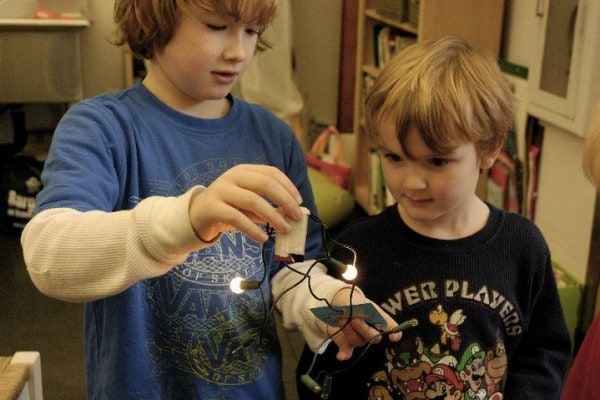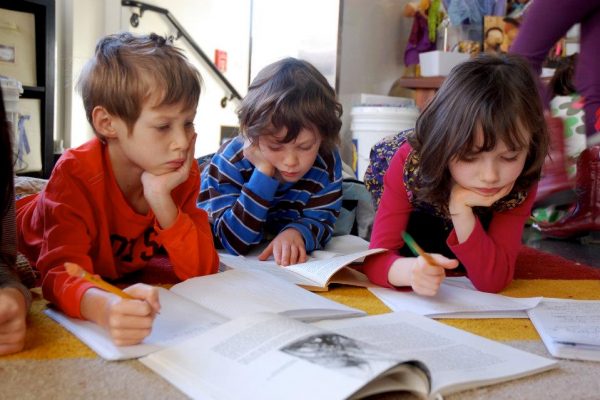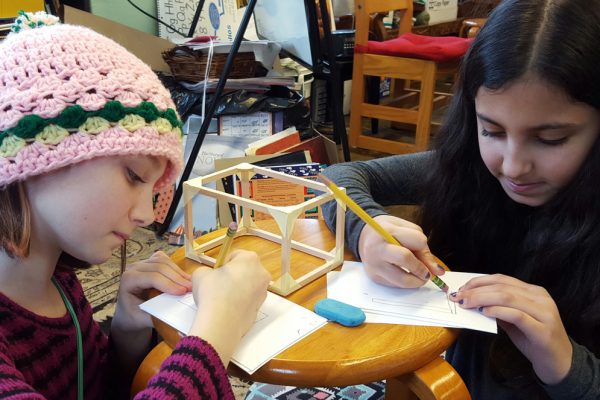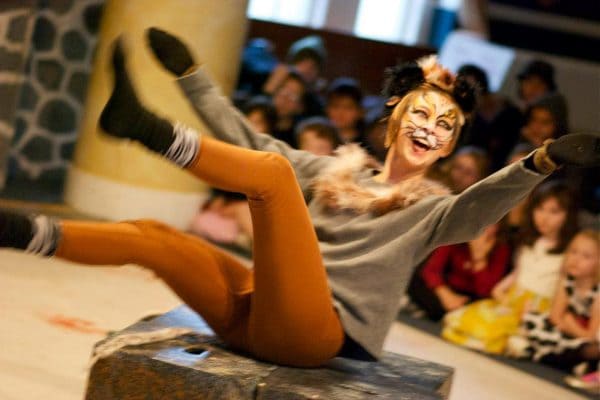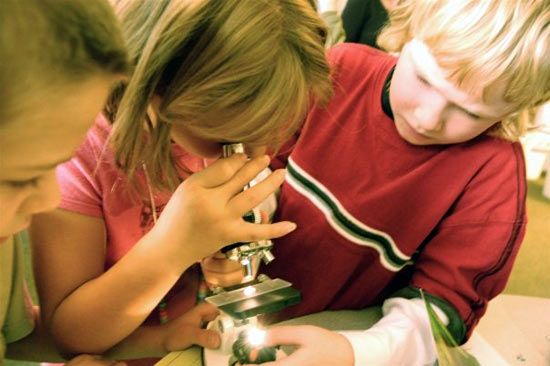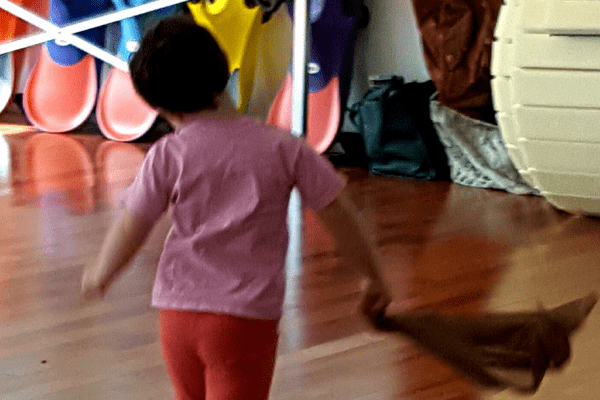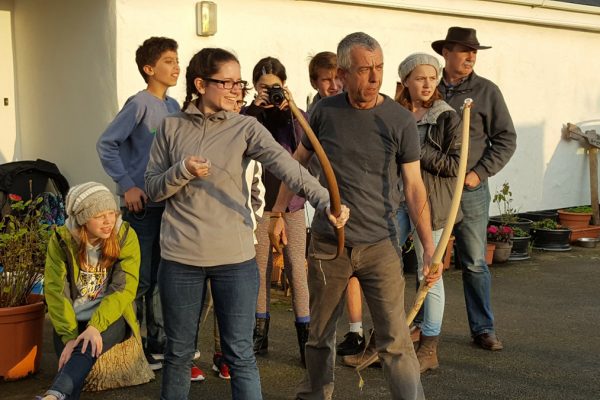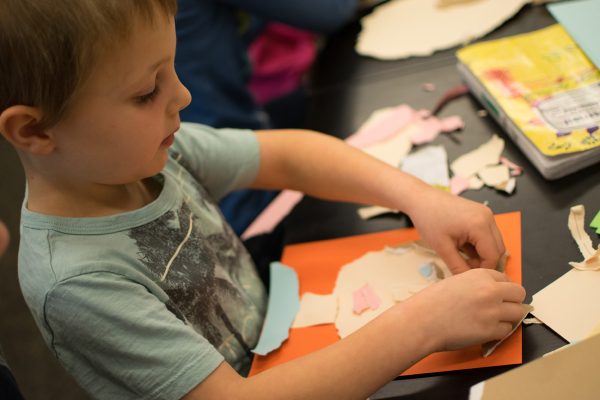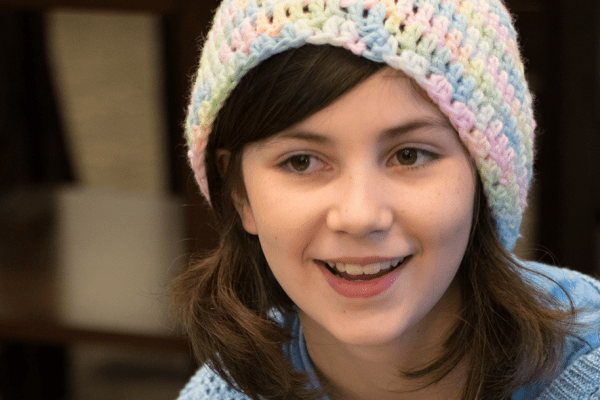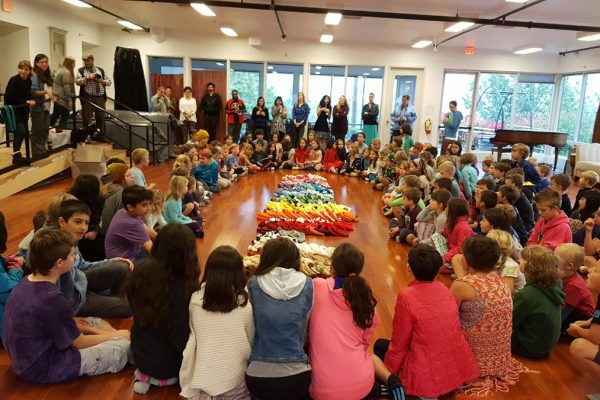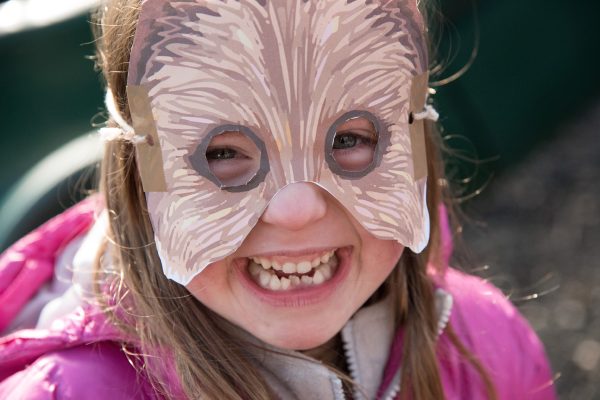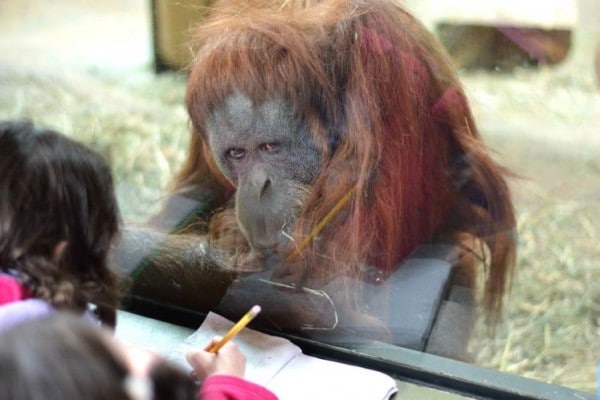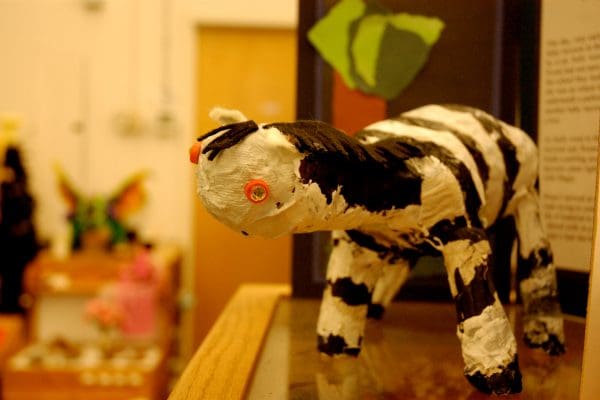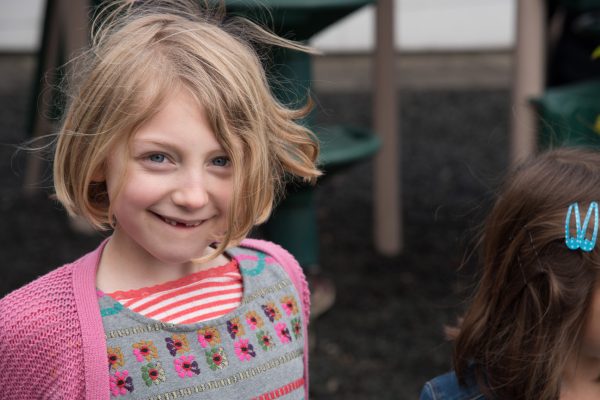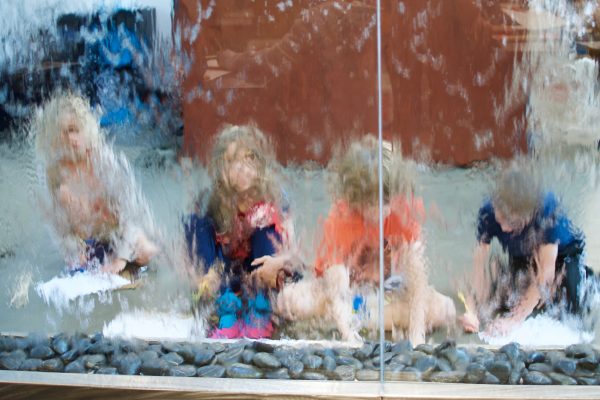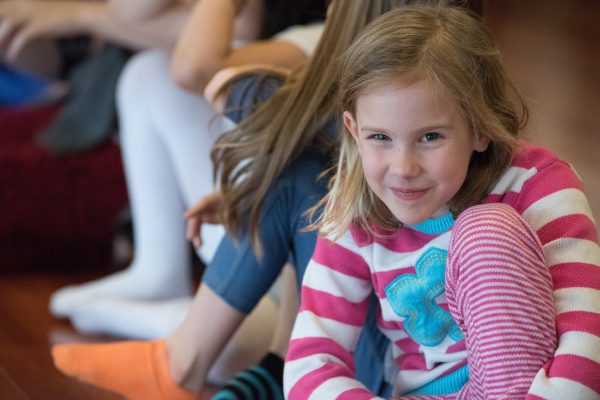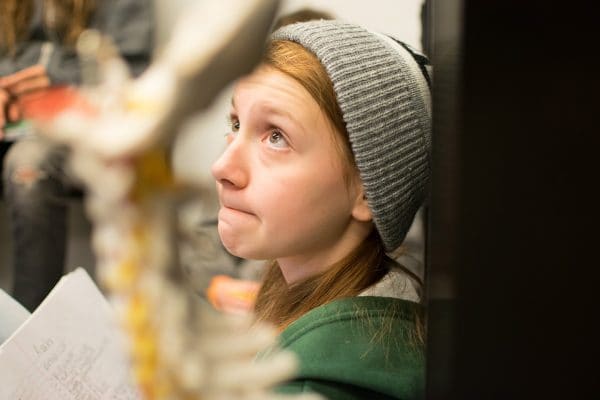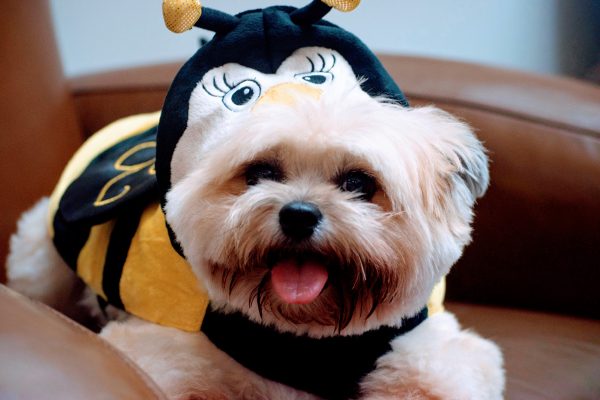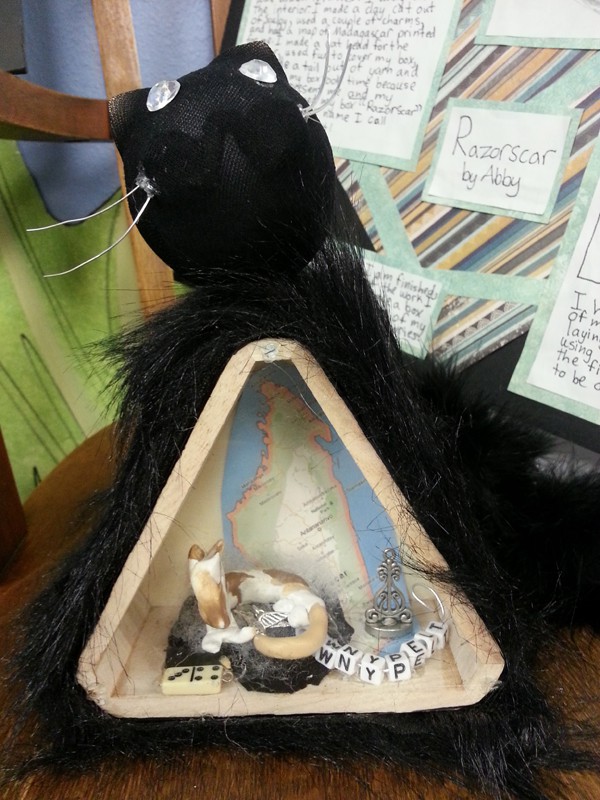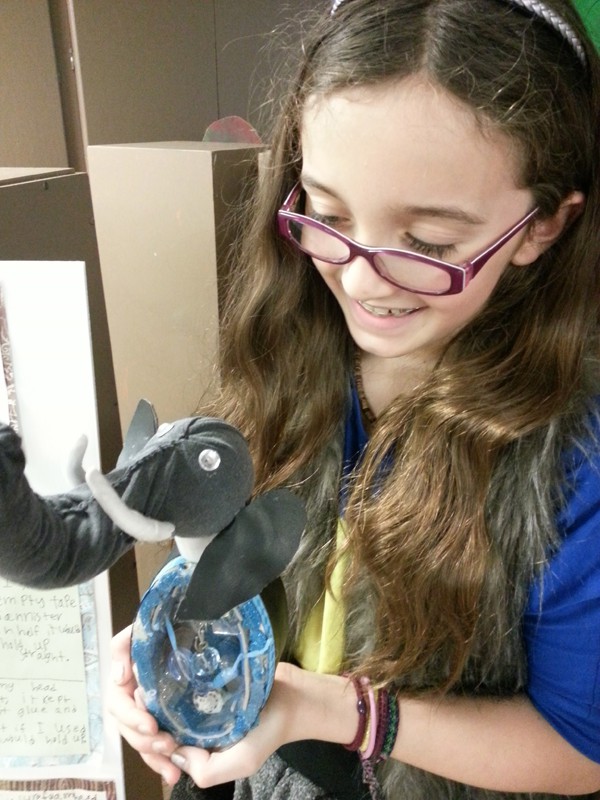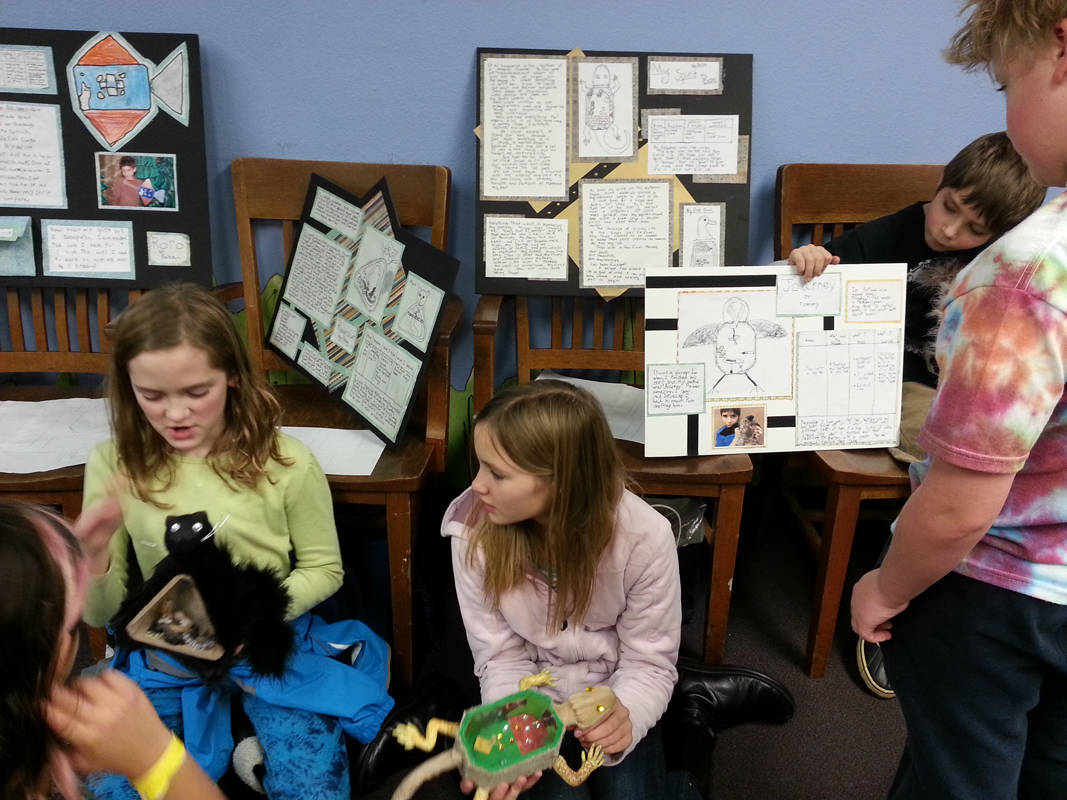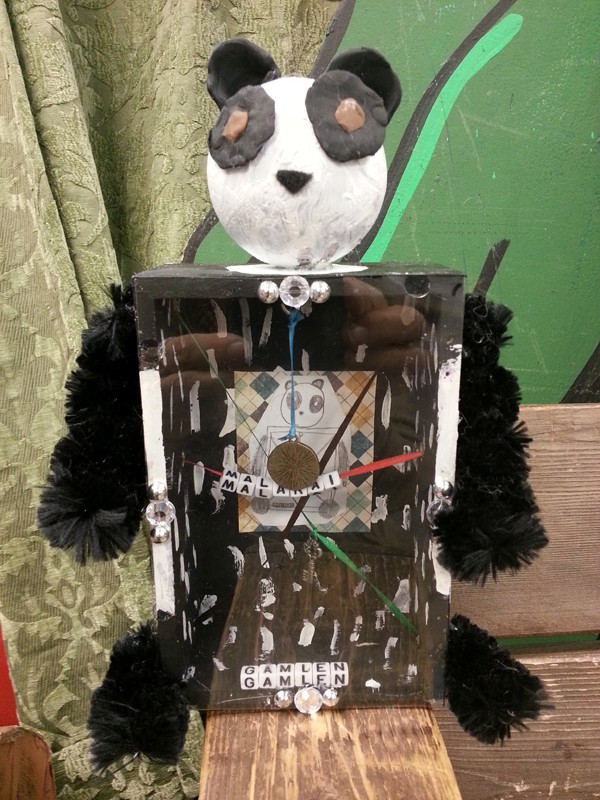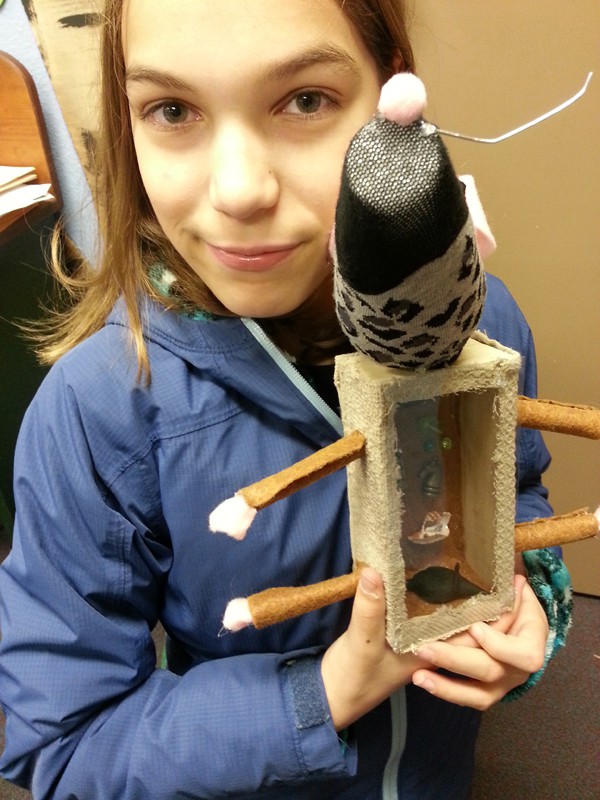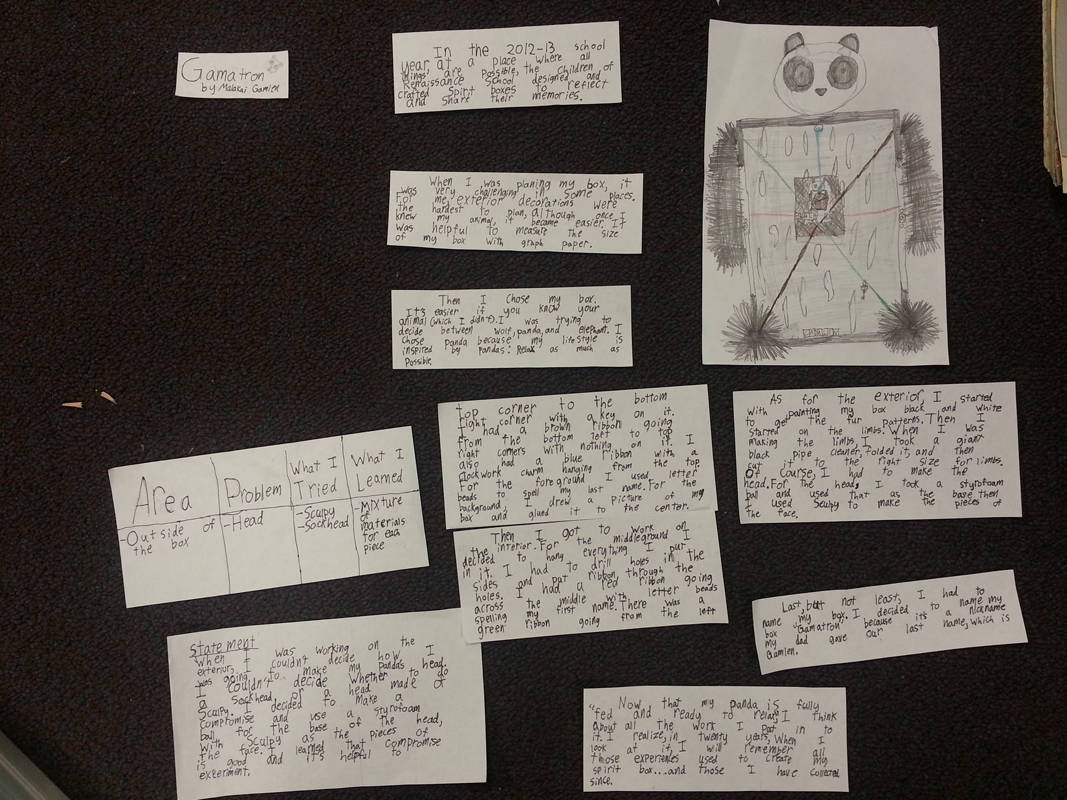Inspired from the Inside Out and Back Again
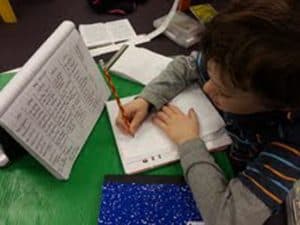 The hunt was on … two educators scanned the booths, dodging the crowds, and diving in to take a closer look. Art in the Pearl was a haven for inspiration … so many personalities, unique materials, and amazing subject matter! And then it appeared… a gallery display of boxes-turned-creatures. Artist Vicki Fish had repurposed wooden boxes to hold and frame internal symbols representing the outer critters that enveloped the rectangular wooden structures. Internal trinkets, textures, and colors created a foreground, middleground, and background, each layer essential to the overall design and the deeper understanding of the life that surrounded it. Perfect!
The hunt was on … two educators scanned the booths, dodging the crowds, and diving in to take a closer look. Art in the Pearl was a haven for inspiration … so many personalities, unique materials, and amazing subject matter! And then it appeared… a gallery display of boxes-turned-creatures. Artist Vicki Fish had repurposed wooden boxes to hold and frame internal symbols representing the outer critters that enveloped the rectangular wooden structures. Internal trinkets, textures, and colors created a foreground, middleground, and background, each layer essential to the overall design and the deeper understanding of the life that surrounded it. Perfect!
We bought two. Both birds. The dangling, articulated legs of the stork, made it irresistible; but the raven, embodying trickster magic, held prime place for purchase. And that was just the beginning…
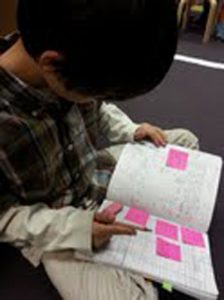 In the belly of the Northwest Children’s Theater, A Renaissance School of Arts and Sciences awaited construction on its permanent structure-home, undergoing significant upgrades in another part of the city. The school had become accustomed to living in an environment of abundance, one in which children’s work was layered on the walls, illustrating the depth of learning that occurred as children cycled in and out of connected projects. Everything had been at our fingertips … or nearby in the NW quadrant of the city. In the transitory stage of the “underground,” everything was confined and defined by boxes on carts, one cart per class, that could be easily packed and hidden away in a closet the moment school ended at 4:00, only to be unpacked and restaged the next morning at 7:00. How would our days, and our work, unfold? This first design brief would test our ability, flexibility, and resourcefulness, as we waded in deeply within the first few weeks of the new school year.
In the belly of the Northwest Children’s Theater, A Renaissance School of Arts and Sciences awaited construction on its permanent structure-home, undergoing significant upgrades in another part of the city. The school had become accustomed to living in an environment of abundance, one in which children’s work was layered on the walls, illustrating the depth of learning that occurred as children cycled in and out of connected projects. Everything had been at our fingertips … or nearby in the NW quadrant of the city. In the transitory stage of the “underground,” everything was confined and defined by boxes on carts, one cart per class, that could be easily packed and hidden away in a closet the moment school ended at 4:00, only to be unpacked and restaged the next morning at 7:00. How would our days, and our work, unfold? This first design brief would test our ability, flexibility, and resourcefulness, as we waded in deeply within the first few weeks of the new school year.
We had decided to continue with our usual processes of inquiry and construction. As we had just doubled in size and ensconced ourselves in an underground “cave,” the year would open with learning about ourselves and each other as we worked both independently and collaboratively. It was to become the platform we would use for developing our  strategies for planning, revising, collaborating, writing, and creating high quality artifacts… all skills that would be introduced to new children, and developed and refined by returning scholars … skills observed by the faculty for assessment and used in application throughout the year.
strategies for planning, revising, collaborating, writing, and creating high quality artifacts… all skills that would be introduced to new children, and developed and refined by returning scholars … skills observed by the faculty for assessment and used in application throughout the year.
The group of thirty 9-13 year olds sat, poised pens above paper, ready to take notes in words and images as the challenge unfolded. We began by looking carefully at the purchased models … What did we notice? Observation is at the heart of our work. Symbols, textures, materials, layers, context, frame… We wondered about the words and quotes tucked into the space… We listed the materials we might need if we were to “create our own box.” Of course, that was the rally cry! We all wanted to make our own!
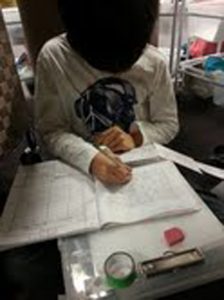 And thus the planning began… Each community member created a list of qualities (nouns) they were striving to integrate into their lives. We shared lists, noted differences in tone and depth among similar attributes, and selected a dozen words individually. Those qualities were transformed into adjectives, descriptors of the people we were becoming, followed by the work we saw ourselves doing in the world. And from earth-plowing that rose the images of creatures, ones that we recognized as ourselves, ones that would naturally grow from our own roots, hold us, and inspire us. That became our greater contexts, our inspired frames.
And thus the planning began… Each community member created a list of qualities (nouns) they were striving to integrate into their lives. We shared lists, noted differences in tone and depth among similar attributes, and selected a dozen words individually. Those qualities were transformed into adjectives, descriptors of the people we were becoming, followed by the work we saw ourselves doing in the world. And from earth-plowing that rose the images of creatures, ones that we recognized as ourselves, ones that would naturally grow from our own roots, hold us, and inspire us. That became our greater contexts, our inspired frames.
Then came the design brief … “Design and construct, using a wooden box frame, a creature context that will hold elements in a foreground, middleground, and background, symbols that represent your journey, aspirations, and power.”
We unpacked the challenge, looking for requirements and areas of interpretation, created a list of work with a corresponding timetable, and a qualitative rubric for the finished art piece.
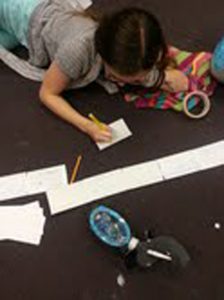 Children selected from a range of boxes. Some plans shifted as boxes were chosen for an interest that had not been considered earlier. We talked about different glues that would lend themselves to permanence with varied materials. We identified tools that could cut, poke, smooth, slice, shape, and clamp. Work began in earnest and design studio time was used to ask questions, pose problems, offer ideas, acknowledge inspiration from others, and thank friends for their support. Some children pushed forward to add electrical circuits to light the internal chamber of the masterwork. Each designer logged progress in journals, explored the use of a challenge chart to explain problems that arose and fell with resolution, choices made along the way, intended and unintended consequences, and learning. And, of course, we used our “train writing” to scaffold the retelling of our journey, from inception to completion. Combining the technical writing with a WWWWW introduction and emotive conclusion, we created expository essays.
Children selected from a range of boxes. Some plans shifted as boxes were chosen for an interest that had not been considered earlier. We talked about different glues that would lend themselves to permanence with varied materials. We identified tools that could cut, poke, smooth, slice, shape, and clamp. Work began in earnest and design studio time was used to ask questions, pose problems, offer ideas, acknowledge inspiration from others, and thank friends for their support. Some children pushed forward to add electrical circuits to light the internal chamber of the masterwork. Each designer logged progress in journals, explored the use of a challenge chart to explain problems that arose and fell with resolution, choices made along the way, intended and unintended consequences, and learning. And, of course, we used our “train writing” to scaffold the retelling of our journey, from inception to completion. Combining the technical writing with a WWWWW introduction and emotive conclusion, we created expository essays.
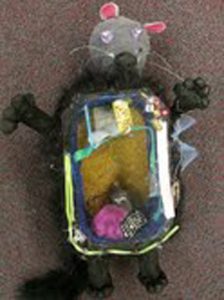 In each sample of writing, children explored voice, word choice, and literary arts elements that make writing interesting. Each submission in draft was an opportunity to see how children applied the skills they were learning to make their pieces readable: playful punctuation, spelling capitalization…
In each sample of writing, children explored voice, word choice, and literary arts elements that make writing interesting. Each submission in draft was an opportunity to see how children applied the skills they were learning to make their pieces readable: playful punctuation, spelling capitalization…
Documentation of progress was collected by each artist-designer-engineer to create an exhibition for public viewing and inspiration, taking into consideration size, spacing, penmanship, composition, and craftsmanship of writing selections. Displays were enhanced through thoughtful application of composition, color, materials, and symbolism.
The message of “becoming” in relationship to attributes and a central image that embodies positive power was over-riding and gave the expanding community a sense of who walked among us… Who are we? Who will we be?
 The results were stunning … so much so that parents began to comment on their own hopes of making something similar someday. So, we hosted a parent workshop. In the evening, a number of adults came together and tackled the same challenge. We talked about the writing strategies the children used and about the design elements they were applying. The parents’ journey paralleled the children’s path as they worked with focus and supported each other’s processes along the way, sharing life stories that would cause specific choices to be made in relation to symbols and materials. The stories were heartfelt, sometimes wrenching, of overcoming obstacles and final triumph. We learned a great deal about each other that night.
The results were stunning … so much so that parents began to comment on their own hopes of making something similar someday. So, we hosted a parent workshop. In the evening, a number of adults came together and tackled the same challenge. We talked about the writing strategies the children used and about the design elements they were applying. The parents’ journey paralleled the children’s path as they worked with focus and supported each other’s processes along the way, sharing life stories that would cause specific choices to be made in relation to symbols and materials. The stories were heartfelt, sometimes wrenching, of overcoming obstacles and final triumph. We learned a great deal about each other that night.
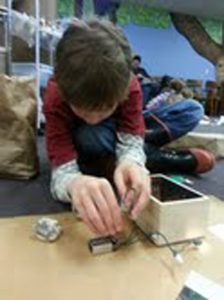 At the close of the evening, we decided to return again to complete the work together. One parent asked if they could display their work at the trimester’s Celebration of Learning. Of course! And several weeks later, a few parents gathered at a home to complete the full project, including the writing processes. Amazing!
At the close of the evening, we decided to return again to complete the work together. One parent asked if they could display their work at the trimester’s Celebration of Learning. Of course! And several weeks later, a few parents gathered at a home to complete the full project, including the writing processes. Amazing!
One late fall morning, three parents came to join the morning circle and share their work. They were excited and nervous. Each one shared a very personal story housed in their sculptures of repurposed materials. They talked about their choices and what had to be left out as well as included. Reverence. Powerful pauses. The children respectfully listened … intent … and asked quiet questions that illustrated their personal connection to each adult project. Teary eyes, opened mouths, shivers, admiration … It was a circle of support for artists of all ages, with mutual gratitude and a deeper understanding of each other and ourselves.
